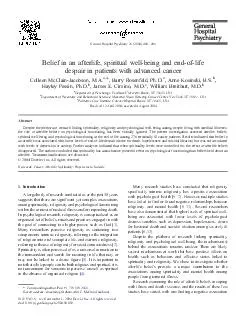/


A a Barry Rosenfeld PhD Anne Kosinski BS Hayley Pessin PhD James E Cimino MD William Breitbart MD Department of Psychology Fordham University Bronx NY 10458 USA Department of Psychiatry and Behavioral Sciences Memorial Sloan Kettering Cancer Cent ID: 46595
Download Pdf The PPT/PDF document "Belief in an afterlife spiritual wellbei..." is the property of its rightful owner. Permission is granted to download and print the materials on this web site for personal, non-commercial use only, and to display it on your personal computer provided you do not modify the materials and that you retain all copyright notices contained in the materials. By downloading content from our website, you accept the terms of this agreement.
Beliefinanafterlife,spiritualwell-beingandend-of-lifedespairinpatientswithadvancedcancerColleenMcClain-Jacobson,M.A.,BarryRosenfeld,Ph.D.,AnneKosinski,B.S.HayleyPessin,Ph.D.,JamesE.Cimino,M.D.,WilliamBreitbart,M.D.DepartmentofPsychology,FordhamUniversity,Bronx,NY10458,USADepartmentofPsychiatryandBehavioralSciences,MemorialSloanKetteringCancerCenter,NewYork,NY10021,USAPalliativeCareInstitute,CalvaryHospital,Bronx,NY10458,USAReceived12April2004;accepted4August2004Despitetheplethoraofresearchlinkingspirituality,religiosityandpsychologicalwell-beingamongpeoplelivingwithmedicalillnesses,theroleofafterlifebeliefsonpsychologicalfunctioninghasbeenvirtuallyignored.Thepresentinvestigationassessedafterlifebeliefs,spiritualwell-beingandpsychologicalfunctioningattheendoflifeamong276terminallyillcancerpatients.Resultsindicatedthatbeliefinanafterlifewasassociatedwithlowerlevelsofend-of-lifedespair(desirefordeath,hopelessnessandsuicidalideation)butwasnotassociatedwithlevelsofdepressionoranxiety.Furtheranalysesindicatedthatwhenspiritualitylevelswerecontrolledfor,theeffectofafterlifebeliefsdisappeared.Theauthorsconcludedthatspiritualityhasamuchmorepowerfuleffectonpsychologicalfunctioningthanbeliefsheldaboutanafterlife.Treatmentimplicationsarediscussed. *Correspondingauthor.Fax:+17185182656.E-mailaddress:cmcclain@fordham.edu(C.McClain-Jacobson).GeneralHospitalPsychiatry26(2004)484486 betweenafterlifebeliefsanddeathanxietyanxietyandanotherfindingnorelationshipbetweenthesevariableses.However,mostofthesestudiesfocusedonhealthycollegestudentsandadultsratherthanmedicallyillindividuals,raisingquestionsastotheecologicalvalidityoffindingsfindings.Inresponsetothisshortcoming,westudiedafterlifebeliefsinagroupofterminallyillcancerpatientsandanalyzedwhetherthesebeliefswereassociatedwithpsychologicaldistressandend-of-lifedespair.2.Method2.1.ParticipantsParticipantswerenewlyadmittedtoapalliativecarehospitalforterminallyillcancerpatientsintheNewYorkCityarea.Inordertobeeligibleforstudyparticipation,patientswererequiredtoscore20oraboveontheMini-MentalStateExamination(MMSE)MMSE),whichwasadministeredtoallEnglish-speakingpatientswhowereabletocompletethemeasure.UponpassingtheMMSE,patientswereofferedparticipationinthestudyand,ifwilling,providedwritteninformedconsent.2.2.ProceduresStudyparticipantswereadministeredavarietyofself-reportandclinician-ratedinstrumentsatbedsidebyoneormorestudyinvestigators.Theinterviewstookplaceoveraperiodofonetothreesessions,mostwithin2weeksofadmissiontothehospital.Beliefinanafterlifewasassessedwiththreequestions:Doyoubelieveinanafterlife?yourbeliefsaboutanafterlifecomfortingtoyou?yourbeliefsaboutanafterlifedistressingtoyou?(Subjectsansweredyes,no,orunsuretoeach.)Spiritualwell-beingwasassessedwiththeFunctionalAssessmentofChronicIllnessTherapySpiritualWell-BeingScale(SWB)(SWB),a12-itemmeasuredesignedtoassesstwoaspectsofspiritualwell-being:meaning/peaceandfaithmakingnomentionofadivine,God-likefigure.Items,whicharescoredona5-pointLikert-typescale,includeIamabletoreachdowndeepintomyselfforcomfortIampeaceful.PsychologicaldistressanddespairweremeasuredwiththeHamiltonDepressionRatingScale(HDRS)HDRS),HospitalAnxietyandDepressionScale(HADS)S),BeckHope-lessnessScale(BHS))andtheScheduleofAttitudestowardaHastenedDeath(SAHD)(SAHD).3.ResultsAtotalof276patients(meanage,65.9years,S.D.=13.7)participatedinthestudy,including175(63.4%)whoreportedbeliefinanafterlife,47(17.0%)whodidnotbelieveinanafterlifeand54(19.6%)whowereunsureregardingtheirbeliefs.Onehundredeighty-eight(68.4%)oftheparticipantsreportedthattheyfoundcomfortintheirbeliefs,56(20.4%)reportedfindingnocomfortand31(11.3%)wereunsureiftheirbeliefsprovidecomforttothem.Furthermore,only21(7.6%)oftheparticipantsreportedthattheirbeliefsweredistressingtothem,233(84.4%)reportedthattheirbeliefsarenotdistressingtothemand22(8.0%)wereunsureastowhethertheirbeliefsweredistressingtothem.ThemajorityoftheparticipantswereCaucasian(=183,66.3%)andfemale(=158,57.2%),andapproximatelyhalfidentifiedthemselvesasCatholic(=135,49%).Ananalysisofvarianceindicatedthatthoseinthegroupwereyoungerthanthoseinnobeliefgroups(=.048).Therewasnogenderorracial/ethnicdifferencesinafterlifebeliefsalthoughdifferencesdidexistacrossthedifferentreligiousaffiliations,with72%ofCatholicsreportingbeliefinanafterlifecomparedto64%ofProtestantsand46%ofJewishparticipants.Atestindicatedthatthosewhodobelieveinanafterlifeweremorelikelythanthoseinthenonbeliefandunsuregroupstoreportthattheirbeliefswerecomfortingtothem(=115.4,.001).However,therewerenodiffer-encesacrossthethreegroupswithrespecttowhethertheirbeliefsweredistressingtothem.AsdisplayedinTable1,therewasnosignificantdifferenceinanxietyordepressionacrossthethreeafterlifegroups;however,levelsofhopelessness,desireforhasteneddeathandsuicidalideationdiddiffersignificantly.Specif-ically,patientswhoreportedbeliefinanafterlifewerelesshopeless,hadlessdesireforhasteneddeathandlesssuicidalideationthanthosewhodidnotbelieveinanafterlifeorthosewhowereunsureabouttheirbeliefs.Theseeffectsremainedafteragewascontrolledfor.Itwasthentestedwhethertherewasaninteractionbetweenonesbeliefinanafterlifeandtheeffectthatbeliefhasontheperson(ifitiscomfortingordistressingtohimorher)inpredictingend-of-lifedespair.NoneoftheinteractiontermsweresignificantintheANOVAmodels.Afinalstepwastodeterminewhethertheafterlifebeliefscontinuedtoinfluencehopelessness,desireforhasteneddeathandsuicidalideationaftercontrollingforspiritualwell-beingmoregenerally.Whenspiritualwell-beingwasenteredasacovariatewithafterlifebeliefintoageneral Table1Beliefinanafterlifeandpsychologicaldistress/despairvariablesYes=175)=47)(54)DistressSWB3.2(.74)2.3(1.1)2.8(.97).0001HADS4.2(4.2)4.0(4.5)3.5(3.8).64HDRS10.0(6.0)11.3(6.5)10.3(6.3).47BHS4.6(4.0)7.9(4.6)6.0(5.1).0001SAHD3.5(3.7)5.4(4.6)3.9(4.3).02712.0%(20/175)27.7%(13/47)16.1%(10/54).029Allnumbersreflectmeans(S.D.);valuesbasedonunivariateexceptsuicidalideation(%/C.McClain-Jacobsonetal./GeneralHospitalPsychiatry26(2004)484486 linearmodel,theeffectofafterlifewasnolongersignificantinanyofthemodels,whereasspiritualwell-beinglevelaccountedforalargeeffectineachmodel.4.DiscussionTheinfluenceofafterlifebeliefsonpsychologicalfunctioningattheendoflifeisanincreasinglyinterestingquestionformentalhealthcliniciansandresearchers.Thisstudy,whichrepresentsoneofthefirstsystematicanalysesofafterlifebeliefsinterminallyillpatients,foundlowerlevelsofend-of-lifedespair(hopelessness,desireforhasteneddeathandsuicidalideation)amongthoseindivid-ualswhobelieveinanafterlifecomparedtothosewhoareeitherunsureordonotmaintainsuchbeliefs.However,whenmultivariateanalysesincludedameasureofspiritualwell-being,thebeneficialeffectofafterlifebeliefsdisap-peared,suggestingthatspiritualityhasamuchmorepowerfuleffectonpsychologicalfunctioningthanbeliefsheldaboutanafterlife.ThisfindingisconsistentwithMarronesssuggestionthattheprocessinwhichonefindscomfortandprotectionduringtheendoflifeismoreimportantthantheactualbeliefinlifeafterdeath.Thepowerfuleffectofspiritualwell-beingonend-of-lifedespair(whichreplicatesagrowingliteratureonspiritualwell-beinganddepression)sion)hasimportantimplica-tionsfortreatment.Interventionsaimedatincreasingapersonsspiritualwell-beinganddevelopingasenseofmeaningandpeacewithinoneselfmayhavesubstantialbenefitsforimprovingmentalhealthattheendoflife.Moreimportantly,byseparatingsuchinterventionsfromreligionandreligiousbeliefs,theseinterventionscanhavebroaderappealforpatientswhodonotholdstrongtraditionalreligiousbeliefsandcanbedeliveredbyawiderangeofmentalhealthclinicians.Despiteitssignificantfindingsandimplications,itisimportanttonotethatthisstudyisnotwithoutlimitations.Becausethisstudywascross-sectionalinnature,wecannotstatethateitherafterlifebelieforspiritualwell-beingpeopletoexperiencemoreorlessdespairasdeathapproaches;wecanonlystatethattheyareassociatedatonepointintime.Additionally,becausethemajorityoftheparticipantswereCaucasianandCatholic,itisunknownwhethertheresultsofthisstudy,thatspiritualwell-beingisastrongerpredictorofend-of-lifedespairthanafterlifebeliefs,wouldbethesameforpeopleofdifferentethnicgroupsorreligions.Furtherresearchinthisareaisnecessarytodeterminethegeneralizabilityoftheseresults.AcknowledgmentsWethankthefollowingcolleagueswhoparticipatedindatacollectionandmanagementofthestudy:BrookeMyersSorger,JenniferAbbey,MichelleGalietta,ChristianNelson,AllisonRodbell,MeganOlden,RobertBresciaandMaryannSantasiero.Furthermore,wethanktheparticipantsinthisstudy,terminallyillmenandwomenwhogavetheirtimeandefforttoadvanceourknowledgeofthedyingprocess.TheNationalInstituteofNursingResearch(WilliamBreitbart;GrantNo.NR-05183)andtheAmericanFoundationforSuicidePrevention(BarryRosenfeld)sponsoredthisstudy.References[1]EmblemJD.Religionandspiritualitydefinedaccordingtocurrentuseinnursingliterature.JProfNurs1992;8:417.[2]AllportGW,RossJM.Personalreligiousorientationandprejudice.JPersSocPsychol1967;5:43243.[3]MuldoonM,KingN.Spirituality,healthcare,andbioethics.JReligHealth1995;34:32949.[4]IronsonG,SolomonG,BalbinE,OCleireighC,GeorgeA,KumarM,etal.TheIronson-Woodsspirituality/religiousnessindexisassociatedwithlongsurvival,healthbehaviors,lessdistress,andlowcortisolinpeoplewithHIV/AIDS.AnnBehavMed2002;24(1):3448.[5]GeniaV,ShawDG.Religion,intrinsic-extrinsicorientation,anddepression.RevReligRes1991;32:27683.[6]FehringR,MillerJ,ShawC.Spiritualwell-being,religiosity,hope,depression,andothermoodstatesinelderlypeoplecopingwithcancer.OncolNursForum1997;24(4):66371.[7]KoenigHG,LarsonD.Religionandmentalhealth:evidenceforanassociation.IntRevPsychiatry2001;13(2):6778.[8]NelsonC,RosenfeldB,BreitbartW,GaliettaM.Spirituality,religion,anddepressionintheterminallyill.Psychosomatics2002;43(3):21320.[9]WoodsT,AntoniM,IronsonG,KlingD.ReligiosityisassociatedwithaffectiveandimmunestatusinsymptomaticHIV-infectedgaymen.JPsychosomRes1999;46(2):16576.[10]FitchettG,RybarcyzkB,DeMarcoGA,NicholasJJ.Theroleofreligioninmedicalrehabilitationoutcomes:alongitudinalstudy.RehabilPsychol1999;44:33353.[11]PargamentK,SmithB,KoenigH,PerezL.Patternsofpositiveandnegativereligiouscopingwithmajorlifestressors.JSciStudyRelig1998;37(4):71024.[12]McClainC,RosenfeldB,BreitbartW.Theinfluenceofspiritualwell-beingonend-of-lifedespairinagroupofterminallyillcancerpatients.Lancet2003;361:16037.[13]LundhL,RadonV.Deathanxietyasafunctionofbeliefinanafterlife.AcomparisonbetweenaquestionnairemeasureandaStroopmeasureofdeathanxiety.PersIndividDiffer1998;25(3):48794.[14]RoseB,OSullivanM.Afterlifebeliefsanddeathanxiety:anexplorationoftherelationshipbetweenafterlifeexpectationsandfearofdeathinanundergraduatepopulation.OmegaJDeathDying2002;45(3):22943.[15]FolsteinM,FolsteinS,McHughP.Mini-mentalstate:apracticalmethodofgradingthecognitivestateofpatientsfortheclinician.JPsychiatrRes1975;1:18998.[16]BradyM,PetermanA,FitchettG,MoM,CellaD.Acaseforincludingspiritualityinqualityoflifemeasurementinoncology.Psychooncology1999;8:41728.[17]HamiltonM.Aratingscalefordepression.JNeurolNeurosurgPsychiatry1960;23:5661.[18]ZigmundAS,SnaithRP.Thehospitalanxietyanddepressionscale.ActaPsychiatrScand1983;67(6):36170.[19]BeckA,WeissmanA,LesterD,TrexlerL.Themeasurementofpessimism:theBeckHopelessnessScale.JConsultClinPsychol1974;42:8615.[20]BreitbartW,RosenfeldB,PessinH,KaimM,Funesti-EschJ,GaliettaM,etal.Depression,hopelessness,anddesireforhasteneddeathinterminallyillpatientswithcancer.JAMA2000;284:290711.[21]MarroneR.Dying,mourning,andspirituality:apsychologicalperspective.DeathStud1998;23(6):495519.C.McClain-Jacobsonetal./GeneralHospitalPsychiatry26(2004)484486